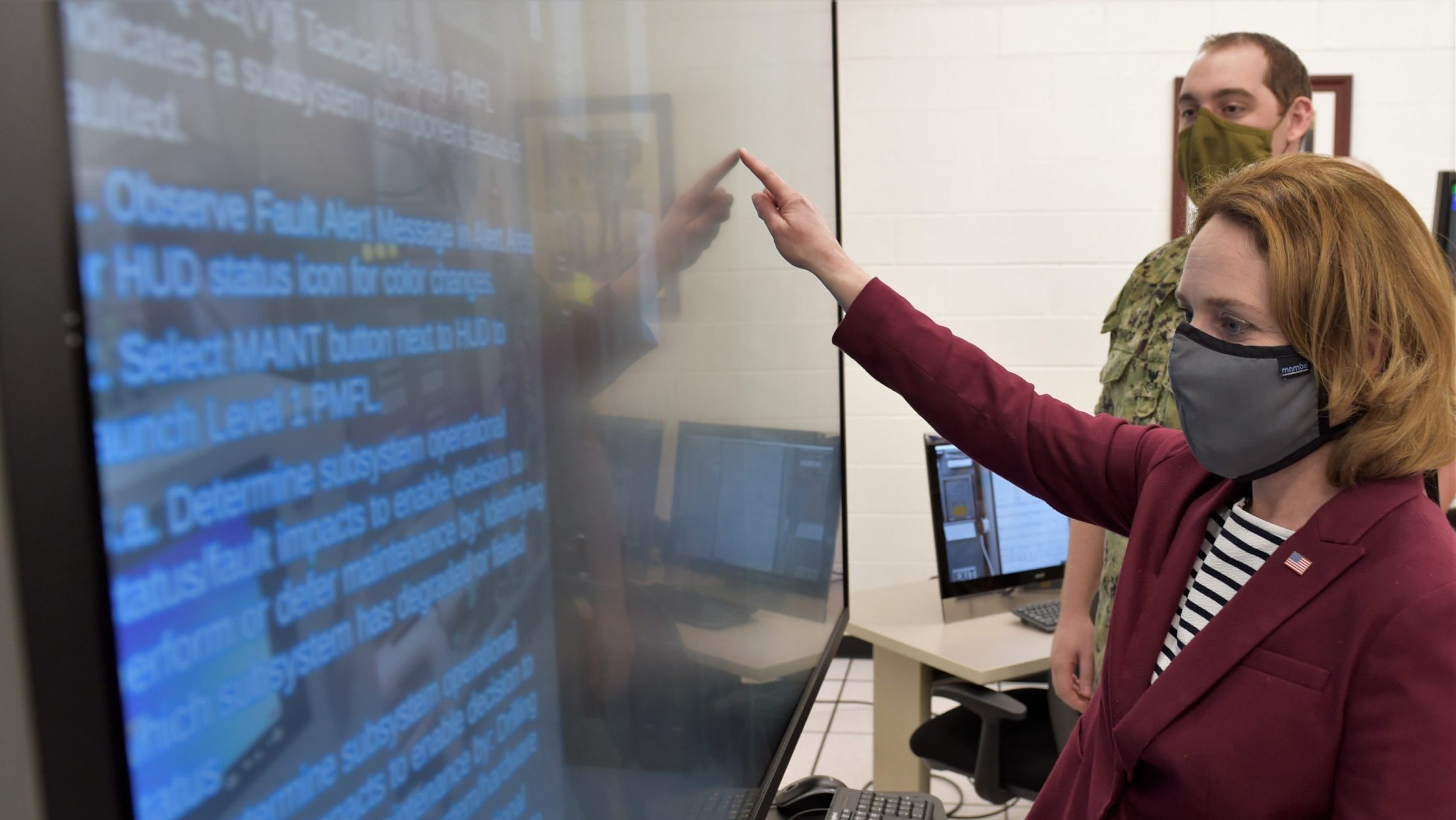
Deputy Secretary of Defense Kathleen H. Hicks participates in a Multipurpose Reconfigurable Training System 3D® (MRTS 3D®) technology training device demonstration and discussion with staff at the Center for Information Warfare Training and Information Warfare Training Command (IWTC) Corry Station in April 2020. (U.S. Navy photo by Glenn Sircy)
WASHINGTON: The Pentagon has released its long-awaited Responsible Artificial Intelligence (RAI) Strategy and Implementation Pathway, acknowledging that the Defense Department won’t be able to maintain a competitive advantage without transforming itself into an AI-ready and data-centric organization that holds RAI as a prominent feature.
The enterprise-wide strategy, signed by Deputy Defense Secretary Kathleen Hicks and published Wednesday [PDF], sets the Defense Department up for the next step in its AI journey by outlining several action items surrounding test and evaluation requirements and bolstering its digital workforce.
“Implementing RAI in the DoD will not succeed with a set of rigid, one-size-fits-all requirements,” according to the strategy. “A flexible approach is required to foster innovative thinking, as needs and complexity will vary based on factors such as technical maturity and context in which AI will be used.”
The new document comes more than two years after DoD adopted its AI Ethical Principles and just over a year after it issued its RAI memorandum that directed the department’s approach to RAI. The new strategy includes a set of “foundational tenets”: RAI governance, warfighter trust, AI product and acquisition lifecycle, requirements validation, RAI ecosystem and AI workforce.
“It is imperative that the DoD adopts responsible behavior, processes and objectives and implements them in a manner that reflects the Department’s commitment to its AI Ethical Principles,” the strategy says. “Failure to adopt AI responsibly puts our warfighters, the public and our partnerships at risk.”
Each tenet is accompanied by lines of effort, corresponding offices of primary responsibility and the estimated timeframe for implementation. The recently stood up Chief Data and AI Office will serve as the lead for implementing RAI.
RELATED: Lyft Exec Craig Martell Tapped As Pentagon’s AI Chief: Exclusive Interview
Under the RAI requirements tenet, the CDAO in coordination with DoD component leads — the office of the assistant to the secretary of defense for privacy, civil liberties and transparency; the joint staff; and the military departments — will create a repository of AI-related common use cases, mission domains and system architectures to “facilitate reusability.”
The CDAO will also develop an acquisition toolkit “that draws upon best practices and innovative research from the DoD enterprise, industry and the academic community, as well as commercially available technology where appropriate.” The office will develop the toolkit in coordination with the offices of the under secretary for research and engineering and acquisition and sustainment.
The toolkit itself will include a set of operationally-relevant RAI-related evaluation criteria, guidance on how industry can meet DoD’s AI Ethical Principles and “standard AI contract language that provides clauses for: independent government [test and evaluation] of AI capabilities, methods of immediate remediation when the vendor-provided AI capabilities cannot be used in accordance with the DoD AI Ethical Principles, requesting training and documentation from vendors, performance monitoring of AI capabilities, and appropriate data deliverables and rights” and any other relevant resources.
The assistant secretary of defense for legislative affairs with the CDAO will also develop a department-wide legislative strategy to “ensure appropriate engagement with the CDAO and consistent messaging, technical assistance, and advocacy to Congress.”
In another line of effort, the CDAO and the office of the under secretary of defense for research and engineering will be responsible for providing a prioritized list of research gaps in RAI-related fields to the White House National AI Initiative Office to encourage funding by the National Institute of Standards and Technology, Department of Education and National Science Foundation.
As for the AI workforce, the strategy outlines efforts to bolster it: developing a mechanism to identify and track AI expertise across DoD by leveraging existing coding efforts and developing standardized personnel coding mechanisms; conducting a gap analysis to determine whether any additional skills are needed to successfully implement RAI; and other efforts to recruit and maintain AI experts.
Separate from the workforce efforts outlined in the RAI Strategy and Implementation Pathway, the CDAO and John Sherman, DoD’s chief information officer, revealed recently that their offices are crafting a new digital workforce strategy that will be critical to getting after the talent the CDAO office will need.
Ultimately, the Pentagon’s desired end state for RAI is trust, according to the strategy. To achieve this desired end state, DoD can’t rely solely on technological advancements.
“Key factors of trustworthiness also include the ability to demonstrate a reliable governance structure, as well as the provision of adequate training and education of the workforce,” according to the strategy. “These efforts will help foster appropriate levels of trust, enabling the workforce to move from viewing AI as an enigmatic and incomprehensible technology to understanding the capabilities and limitations of this widely adopted and accepted technology.”
Major trends and takeaways from the Defense Department’s Unfunded Priority Lists
Mark Cancian and Chris Park of CSIS break down what is in this year’s unfunded priority lists and what they say about the state of the US military.


























